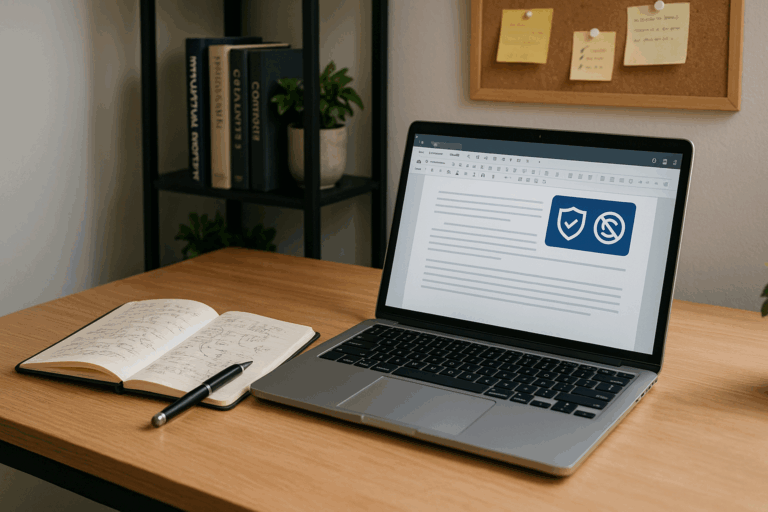🛡️ Your content is your digital currency, and in this highly competitive online arena, it’s imperative to keep it secure and protect it from theft. Whether you’re a developer, writer, or artist, your work is a valuable asset, and it deserves the utmost protection.
But how can you ensure that your content is shielded from the nefarious elements of the online world? How can you protect your intellectual property rights? This blog post is your comprehensive guide to prevent content theft and protect your intellectual property.🔒
Expect an in-depth exploration of different techniques and strategies to keep your work secure, including understanding intellectual property rights, implementing digital rights management, and employing plagiarism detection tools. By the end of this guide, you’ll have a holistic understanding of the various measures you can put in place to ensure your intellectual property is not only protected but thrives in this digital era.💼
Before diving into the thick of it, it’s essential to establish a clear understanding of what constitutes intellectual property. While this may seem like a given, many content creators often overlook the importance of this concept, leaving their work vulnerable to theft. So, we’ll be starting off with a deep dive into the foundations of intellectual property, its different forms, and why it is essential to protect it.
Defining Intellectual Property
Intellectual property refers to creations of the mind, such as inventions; literary and artistic works; designs; and symbols, names, and images used in commerce. It’s a broad term that encompasses various forms, including copyrights, patents, and trademarks. While these might seem like legal jargon, each form plays a critical role in securing your work. Having a robust understanding of these forms will empower you to protect your intellectual property better.
Content Theft: A Growing Menace
With the rising popularity of the digital landscape, content theft has become a rampant issue. Unfortunately, it’s all too easy for individuals to copy, distribute, or even claim your work as their own. Understanding the gravity of this issue and its potential implications will set the stage for why it’s vital to implement strategies to protect your intellectual property.
Tools and Techniques to Guard Your Content
We’ll delve into the arsenal of tools and techniques at your disposal to safeguard your intellectual property. These range from digital rights management systems to plagiarism detection tools and watermarks. Each tool and technique has its strengths and weaknesses, and understanding these will allow you to choose the most effective ones for your needs.🛠️
By the end of this comprehensive guide, you’ll be well-equipped with the knowledge and tools to guard your content effectively. You’ll be empowered to protect your work, ensuring it remains in your control and benefits you as it should. So, buckle up and get ready for a deep dive into the world of intellectual property protection. It’s time to guard your content and secure your future in the digital world.🔐
Understanding Intellectual Property and its Importance
The concept of intellectual property (IP) revolves around the idea that a person’s original creation, whether it be a piece of writing, a design, an invention, or a brand, should be protected by law. These protections exist to prevent theft or misuse of these original works. Understanding the value and importance of intellectual property is essential for anyone who creates original content, especially in the digital age, where theft and misuse can occur in an instant.
Intellectual property laws provide creators with exclusive rights to their work, ensuring they can profit from their creations without fear of theft. These rights can be incredibly valuable, both financially and personally, to creators. They also stimulate creativity and innovation, promoting economic growth and societal development. As such, protecting intellectual property is not only beneficial to the individual creator, but also to society as a whole.
The theft of intellectual property, often referred to as IP theft, can have devastating effects on creators. It can result in financial losses, damage to the creator’s reputation, and can even discourage future innovation and creativity. Therefore, it is crucial to take measures to guard your content and protect your intellectual property.
Strategies for Protecting Your Intellectual Property Online
The first step in protecting your intellectual property is identifying what you need to protect. This may include written content, designs, logos, inventions, or software code. Once you have identified your intellectual property, you can take steps to secure it. Here are some strategies that can help.
Firstly, it is important to copyright your work. Copyright laws protect original works of authorship, including books, articles, music, and artwork. While copyright is automatic upon creation of a work in many jurisdictions, registering your copyright can provide additional legal protections. For example, a registered copyright can provide evidence of ownership in a legal dispute.
Secondly, consider using a digital watermark or other visible indicator of your ownership. This can deter potential thieves and make it easier to prove ownership in case of a dispute. Additionally, using a digital rights management (DRM) system can help prevent unauthorized access or copying of your work.
YouTube Video: Protecting Your Intellectual Property Online | WIPO (World Intellectual Property Organization)
For a detailed overview on protecting your intellectual property online, check out this insightful video from the World Intellectual Property Organization:
Comparing Tools for Protecting Intellectual Property
Various tools and services can help you guard your content and protect your intellectual property. However, each tool comes with its own strengths and weaknesses. To help you choose the right tool for your needs, consider the following table:
| Tool | Strengths | Weaknesses |
| Copyright Registration | Provides legal evidence of ownership, enables legal actions for infringement | Can be time-consuming and costly |
| Digital Watermarks | Deters theft, easy to implement | Can be removed by sophisticated thieves |
| Digital Rights Management (DRM) | Prevents unauthorized access and copying, can control how your work is used | Can be expensive, may be inconvenient for legitimate users |
Remember, the most effective strategy often involves using a combination of tools. Consider your needs, resources, and the nature of your intellectual property when choosing your strategy.
Practical Tips to Prevent Theft
While legal protections and digital tools are crucial, there are also practical steps you can take to prevent theft of your intellectual property. Here are some tips:
- Be mindful of where and how you share your work. Avoid posting high-resolution or full-size versions of your work online.
- Monitor the use of your work online. Use tools like Google Alerts or image tracking services to keep an eye out for unauthorized uses of your work.
- Take action when theft occurs. This might involve sending a cease-and-desist letter, filing a copyright infringement claim, or pursuing legal action.
Protecting your intellectual property can seem daunting, but with the right strategies and tools, you can guard your content effectively. Remember, your creativity and innovation are valuable – don’t let them be stolen without a fight.

Conclusion
In conclusion, this article sought to provide a thorough, insightful, and accessible exploration of the main concepts that underpin the world of software engineering and IT. Whether discussing the principles of data structures, the importance of agile methodologies, or the ways in which cloud computing is revolutionising the way we approach data storage, it’s my hope that this piece has served as a comprehensive guide for all those seeking to further their understanding in these areas.
Given the sheer breadth of topics covered, it’s worth taking a moment to reiterate some of the key points we’ve discussed.
Firstly, we delved into data structures and algorithms, noting their critical role in software engineering. As we explored, these structures provide a way of organising and managing data, allowing software to function efficiently. To truly understand and apply these concepts effectively, I encourage you to dig deeper by visiting resources like www.datastructures.com or www.algorithms.org. 🧠💻
Next, we looked at agile methodologies and the ways in which they facilitate collaboration and adaptability within software development projects. The agile philosophy places a premium on the ability to respond to change and values human communication. You can learn more about this subject on www.agilemethodology.org. 🔄💬
Lastly, we examined the game-changing nature of cloud computing. This technology offers a more efficient way to store and access data, transforming business practices and creating new opportunities for innovation. For those eager to dive deeper into cloud computing, I recommend visiting www.cloudcomputing.org. ☁️💾
There’s no doubt that these topics are dense and complex. They can, at times, seem daunting and even overwhelming. But they are also fascinating, filled with potential for those willing to delve into the details. They are the building blocks upon which our digital world is constructed, the invisible threads that weave together our software and systems.
While the depth of information here is extensive, it’s important to remember that this is just the tip of the iceberg. As technology continues to evolve at a rapid pace, so too does the need for continuous learning.
So, whether you’re a seasoned professional looking to brush up on your knowledge, or a novice keen to broaden your horizons, I encourage you to keep exploring, keep questioning, and most importantly, keep learning. 🎓💡
Please feel free to comment with any questions, observations or insights you may have. Sharing our knowledge only serves to strengthen our collective understanding. Additionally, don’t forget to share this article with colleagues, peers, or anyone else who might find it useful.
To continue this journey of learning and exploration, why not consider applying what you’ve learnt here in your own projects? The world of software engineering is, after all, a practical one. The most effective learning comes from doing, from trial and error, from applying theory to practice.
Remember, the road to mastery is a long one, paved with challenges and obstacles. But it’s also a journey filled with opportunities for growth, innovation, and discovery. So, buckle up, stay curious, and enjoy the ride! 🚀🌍
Let’s keep pushing the boundaries of what’s possible, and together, we’ll shape the future of technology.



